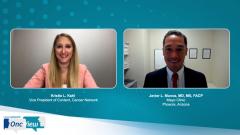
Current Treatment Options for Relapsed/Refractory Follicular Lymphoma
Javier L. Munoz, MD, MS, FACP, describes the effects of R/R FL and discusses the current treatment options available.
Kristie L. Kahl: Hi, and welcome to Cancer Network®’s OncView® program titled, “Updates in Therapies of Relapsed and Refractory Follicular Lymphoma.” I’m Kristie Kahl, vice president of content with Cancer Network®. We have with us today Dr Javier Munoz, director of the lymphoma program at Mayo Clinic in Phoenix, Arizona. Thank you for joining us today, and let’s get started. Dr Munoz, how many patients relapse after frontline therapy?
Javier L. Munoz, MD, MS, FACP: Thank you for the invitation. My main interests are lymphoma, immunotherapy, and CAR [chimeric antigen receptor] T cells. I’m happy to share my experience, and I appreciate your time joining me today.
How many patients with follicular lymphoma relapse? Most oncologists consider the intention of therapy in follicular lymphoma to be palliative instead of curative, which would mean that most patients would eventually relapse. Certainly, there are exceptions to my previous comment. Patients with stage I follicular lymphoma can face long-term remissions after, let’s say, radiation therapy, and some of those patients could potentially be considered cured as time goes by. Allogeneic stem cell transplant can provide a curative approach, but it is not necessarily for everyone, as the procedure is complex and carries morbidity and mortality. CAR T cells have recently been FDA approved for patients with follicular lymphoma who have received 2 or more lines of systemic therapy, but it is too early to make a comment regarding long-term remissions due to the relatively short follow-up that we have so far.
Kristie L. Kahl: How does relapse impact prognosis?
Javier L. Munoz, MD, MS, FACP: It certainly does. A [quick] relapse post first-line therapy is more ominous prognostically compared to a patient who is facing relapse 10 years after first-line therapy. [Carla] Casulo, [MD,] in a very elegant fashion, showed that progression or relapse of follicular lymphoma within 2 years, called POD24, or progression of disease within 24 months after diagnosis, is associated with poor outcome. Now, to answer your question regarding relapse after frontline therapy, I will quote the RELEVANCE trial, which explored rituximab plus lenalidomide versus rituximab plus chemotherapy in advanced follicular lymphoma that was untreated. This was published in the New England Journal of Medicine in 2018. The interim 3-year rate of progression-free survival was 77% for rituximab plus lenalidomide and 78% for rituximab plus chemotherapy in the front line. As time goes by, you would expect fewer patients to stay progression-free and more patients to eventually relapse. As a summary, the timing of the relapse matters, and the choice of initial therapy also matters, as they will factor in when it comes to our decision-making to choose a second-line therapy.
Kristie L. Kahl: What are the treatment options at first relapse in follicular lymphoma?
Javier L. Munoz, MD, MS, FACP: One size does not fit all. The National Comprehensive Cancer Network guidelines mention multiple options for patients with follicular lymphoma in second-line and subsequent therapy, including lenalidomide plus rituximab, or lenalidomide plus obinutuzumab, or the EZH2 inhibitor, tazemetostat. There are also some chemotherapy options mentioned in the guidelines, like R-CVP [rituximab, cyclophosphamide, vincristine, prednisone], bendamustine plus rituximab or obinotuzumab, or R-CHOP [rituximab, cyclophosphamide, doxorubicin, vincristine, prednisone]. I personally try to avoid chemotherapy as much as possible. The only exception would be to use R-CHOP [rituximab, cyclophosphamide, doxorubicin, vincristine, prednisone] when there is histologic or suspected transformation from follicular lymphoma to diffuse large B-cell lymphoma. But short of that, I try to keep R-CHOP [rituximab, cyclophosphamide, doxorubicin, vincristine, prednisone] in my back pocket, not in my front pocket, so to speak, when it comes to follicular lymphoma. The guidelines also mention PI3 kinase inhibitors such as idelalisib, copanlisib, and duvelisib, for patients with follicular lymphoma who have previously received 2 lines of systemic therapy. And there has been a recent addition to the armamentarium in the PI3 kinase family, as umbralisib has also been FDA approved for patients with follicular lymphoma who have received at least 3 prior lines of therapy. Certainly, having so many options is a good problem to have for patients with follicular lymphoma, and the future seems bright for the disease.
Transcript edited for clarity.
Newsletter
Stay up to date on recent advances in the multidisciplinary approach to cancer.

















































































